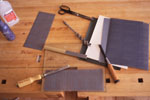
|
|
Table of contents |
A Guide to Honing and Sharpening
Tools and Equipment
| No matter which technology you choose to use to sharpen your stones, the most important thing to learn is how to hold a tool at a consistent bevel angle, and how to determine what is sharp. Everything else after that is a question of the particular sequence used on a particular series of stones. Therefore the primary thrust of this lesson is the technique of sharpening, how to hold a blade, how to get a consistent angle, and how to observe each phase of the sharpening process. This lesson will be demonstrated on American oilstones, although the technique works equally well for the other technologies. To my mind, the principal advantage of Japanese water stones today is that they cut fast. Their principal disadvantage is that they require maintenance. The principal advantage of Arkansas stones is that they last forever and stay flat. Their principal disadvantage is that they cut slower than waterstones. This is especially true on harder Japanese tools and some of the new alloys such as A2. | |
|
Equipment
needed for using oilstones:
|
|
|
All
the equipment shown in this lesson is available in our Museum
Store. Direct links are provided at the conclusion of the lesson
|
|
| A medium India stone, 8 by 2 inches | |
 |
India stones are a synthetic stone made by Norton Abrasives. In theory, a rougher natural stone such as a Washita stone will work, but India stones seem to work best and are inexpensive. |
| An ultra fine Arkansas stone, HB8, 8 by 2 inches | |
 |
Arkansas
stones come in various qualities. What you want is a stone that feels
like glass to the touch; when oiled the stone may become translucent.
Until recently the only source in the US was Norton Abrasives. Currently
other vendors have found what they call "translucent" Arkansas stones.
Part of the reason that Arkansas stones fell out of favor in the 1970's
was that the mass market woodworking retailers did not carry the high
quality stones - only lower quality stones. This problem has been
to some extent mitigated. Arkansas stones are fragile. It is important also important to keep the stone clean so that it doesn't get scratched. The best way of storing them is in a fitted wooden box. |
| An untreated leather strop | |
 |
For a strop, a piece of smooth untreated leather, about 14" long by 3 inches wide is in order. (Not sold in the Museum Store. The best places to obtain a leather strop is in a leather store or leather shoe repair shop - anyone who has leather scraps.) |
| Honing oil | |
|
Either "Bear" Sharpening Oil or, cheaper and just as good, a mixture of: 3 parts kerosene to 1 part heavy mineral oil or 2 parts kerosene to 1 part light mineral oil The more kerosene, the faster the stone will cut. The more mineral oil, the less it will clog. |
|
|
Equipment
Needed for Using Waterstones
|
|
| Three waterstones of the following grits of increasing fineness: 1000, 6000, and 8000 are needed. | |
 |
The two finer grades (6000 and 8000) are sometimes known as respectively as silver and gold stones. For really rough work, a 220 grit stone may be useful, though using a diamond stone is preferrable. The coarse grit water stones must be soaked in water for about a ½ hour before use. Most craftsman just keep the stones soaking in a bucket of water all the time so the stones are always ready. The finer (6000 and 8000) grit stones just need to be doused with water before use. |
| For flattening waterstones a large 220 grit diamond stone is required. | |
 |
In order to really do good work with waterstones it is essential that you have a way of flattening stones. In a pinch a rough piece of wet or dry silicon carbide paper on a piece of glass will work, but a diamond stone is a lot easier to use. |
|
The
Scary Sharp method
|
|
 |
In the past 15 years sheets of microfine abrasives have come on the market. The basic theory of the scary sharp method is to use the sheets of fine abrasives instead of actual honing stones. As I don't use this method, I don't have any material advice to offer. I can think of a lot of limitations to this method, but it's not fair for me to judge something I haven't tried. My major complaint is that the abrasive sheets need to be periodically replaced, adding ongoing maintainance and cost. However for a beginner, it does make it possible to sharpen without the inital investment of an Arkansas stone or a Gold waterstone, both of which are quite expensive. The basic instructions for holding a chisel and maintaining a bevel are identical in all the systems. |